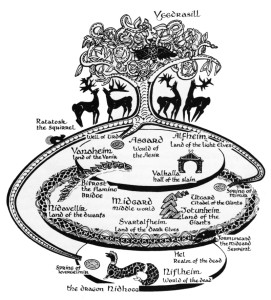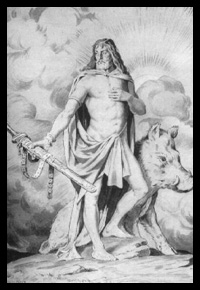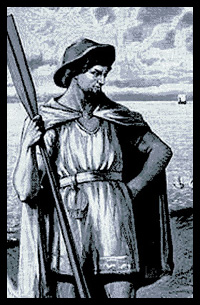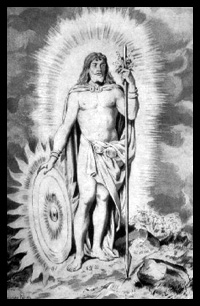Vanaheim (“home of the Vanir”) is the land of the Vanir. It is located in Asgard, on the highest level of the universe.
The collective name for the the principal race of Norse gods; they who lived in Asgard, and with the All-Father Odin, ruled the lives of mortal men, the other was the Vanir.
The Aesir gods under the leadership of Odin, included:
- Balder (god of beauty)
- Bragi (god of eloquence)
- Forseti (god of mediation)
- Freyr (god of fertility, who originally was from the Vanir)
- Heimdall (guardian of the bridge)
- Hod (the blind god)
- Loki (the trickster of the gods)
- Njord (the sea god, and another ex-Vanir)
- Thor (god of thunder)
- Tyr (god of war)
- Vili (brother to Odin)
- Ve (brother to Odin)
- Vidar (Odin’s son)
The goddesses included:
- Freya (the fertility goddess)
- Frigga (Odin’s wife)
- Sif (Thor’s wife)
- Idun (keeper of the apples of youth)
Jotunheim is one of the nine worlds, the homeland of the frost giants and rock giants. Situated in Midgard, on the middle level of the Norse universe, Jotunheim is separated from Asgard by the river Iving, which never freezes over. It lies in the snowy regions on the outermost shores of the ocean. Mimir’s well of wisdom is in Jotunheim, beneath the Midgard root of the ash tree Yggdrasil.
Jotunheim is ruled by Thrym (“uproar”), the feared king of the frost giants. The stronghold of Utgard, the chief city of Jotunheim and the abode of the giants, is ruled by the giant Utgard-Loki. Other strongholds include Gastropnir, home of the giantess Menglad, and Thrymheim (“house of uproar”), mountain stronghold of the giant Thiazi.
 In Norse mythology, Yggdrasil (“The Terrible One’s Horse”), also called the World Tree, is the giant ash tree that links and shelters all the worlds.
In Norse mythology, Yggdrasil (“The Terrible One’s Horse”), also called the World Tree, is the giant ash tree that links and shelters all the worlds.
Beneath the three roots the realms of Asgard, Jotunheim, and Niflheim are located.
Three wells lie at its base: the Well of Wisdom (Mímisbrunnr), guarded by Mimir; the Well of Fate (Urdarbrunnr), guarded by the Norns; and the Hvergelmir (Roaring Kettle), the source of many rivers.
Four deer run across the branches of the tree and eat the buds; they represent the four winds. There are other inhabitants of the tree, such as the squirrel Ratatosk (“swift teeth”), a notorious gossip, and Vidofnir (“tree snake”), the golden cock that perches on the topmost bough. The roots are gnawed upon by Nidhogg and other serpents.
On the day of Ragnarok, the fire giant Surt will set the tree on fire.
Asgard, in Norse mythology, is the abode of the gods. Access to Asgard was possible only by crossing the bridge Bifrost (the rainbow).
Asgard was divided into 12 or more realms in which each principal god had his own luxurious mansion of gold or silver. The most important palace was Valhalla, the home of Odin, the chief of the gods.
Asgard, in Norse mythology, is one of the nine worlds and the homeland of the Aesir, the race of warrior gods. Located on the highest level of the Norse universe, it is surrounded by a high wall of closely fitted stone block
The walls surrounding Asgard were built by Blast (or Hrimthurs), who asked in payment the hand of Freyja plus the sun and the moon. Odin agreed providing the walls be complete in six months. Hrimthurs had a magic horse, named Svadilfari, who helped him in his work. To Odin’s (and the other gods, especially Freya’s) horror, with but a few days left, Blast was almost finished. Loki, the trickster, turned himself into a mare and beguiled the stallion Svadilfari away. The job was not completed in time and no payment was given.
Also found on this level are the worlds of Alfheim and Vanaheim as well as Valhalla, an immense hall where warriors slain in battle await the final conflict.
In the middle of Asgard lies the plain of Idavoll (or Ida) where the Aesir meet to decide important issues. There the gods assemble in the hall of Gladsheim and the goddesses in the hall of Vingolf.
The gods also meet daily at the Well of Urd, beneath the Asgard root of the ash tree Yggdrasil.
Valkyries, in Scandinavian mythology, are the warrior maidens who attended Odin, ruler of the gods. The Valkyries rode through the air in brilliant armor, directed battles, distributed death lots among the warriors, and conducted the souls of slain heroes to Valhalla, the great hall of Odin. Their leader was Brunhilde.
Valhalla (Old Norse Valhöll,”hall of the slain”), in Old Norse mythology, the hall of slain heroes, ruled by the king of the gods, Odin, in the realm of the gods, Asgard.
The hall had 540 doors, through each of which 800 heroes could walk abreast, and the roof was made of shields.
The souls of heroic soldiers killed in battle were brought to Valhalla by warrior maidens called Valkyries. The heroes fought during the day, but their wounds healed before night, when they banqueted with Odin.
 Freyr is Freyja’s twin brother. He is the horned God of fertility, and has some similarities to the Celtic Cernunnos or Herne, although he is NOT the same being. He is known as King of the Alfs (elves). Both the Swedish and the English are said to be descendents of his. The Boar is his sacred symbol, which is both associated with war and with fertility. His golden boar, “Gullenbursti”, is supposed to represent the daybreak. He is also considered to be the God of Success, and is wedded to Gerda, the Jotun, for whom he had to yield up his mighty sword. At Ragnarok, he is said to fight with the horn of an elk (much more suited to his nature rather than a sword.)
Freyr is Freyja’s twin brother. He is the horned God of fertility, and has some similarities to the Celtic Cernunnos or Herne, although he is NOT the same being. He is known as King of the Alfs (elves). Both the Swedish and the English are said to be descendents of his. The Boar is his sacred symbol, which is both associated with war and with fertility. His golden boar, “Gullenbursti”, is supposed to represent the daybreak. He is also considered to be the God of Success, and is wedded to Gerda, the Jotun, for whom he had to yield up his mighty sword. At Ragnarok, he is said to fight with the horn of an elk (much more suited to his nature rather than a sword.)
 Njord is the God of the wind and fertility as well as the sea and merchants at sea and therefore was invoked before setting out to sea on hunting and fishing expeditions. He is also known to have the ability to calm the waters as well as fire.
Njord is the God of the wind and fertility as well as the sea and merchants at sea and therefore was invoked before setting out to sea on hunting and fishing expeditions. He is also known to have the ability to calm the waters as well as fire.
Njord, one of the Vanir gods, was first married to his sister Nerthus and had two children with her, Frey and Freyja. His second wife was Skadi (Skade), a Giantess. When Skadi’s father was killed by the Aesir she was granted three “acts” of reparation one of which was to let her choose a husband from among the gods. She was allowed to pick her new husband but the choice had to be made by looking only at the feet. She picked Njord by mistake, assuming his feet belonged to Balder.
Njord and Skadi could not agree on where to live. She didn’t like his home Noatun at the Sea, and he didn’t like hers Trymheim, in the mountain with large woods and wolves, so they lived the first half of the year in Noatun and the other half in Trymheim.
Njord is said to be a future survivor of Ragnarök in stanza 39 of the poetic Edda:
“In Vanaheim the wise Powers made him and gave him as hostage to the gods; at the doom of men he will come back home among the wise Vanir.”
 Balder, son of Odin and Frigga, the god of Love and Light, is sacrificed at Midsummer by the dart of the mistletoe, and is reborn at Jul (Yule). Supposedly his return will not occur until after the onslaught of the Ragnarok, which I see as a cleansing and enlightenment more than wanton, purposeless destruction. Balder’s blind brother Hodur was his slayer, whose hand was guided by the crafty Loki. He is married to the goddess of Joy, Nanna.
Balder, son of Odin and Frigga, the god of Love and Light, is sacrificed at Midsummer by the dart of the mistletoe, and is reborn at Jul (Yule). Supposedly his return will not occur until after the onslaught of the Ragnarok, which I see as a cleansing and enlightenment more than wanton, purposeless destruction. Balder’s blind brother Hodur was his slayer, whose hand was guided by the crafty Loki. He is married to the goddess of Joy, Nanna.
Balder’s dreams are the beginning of the end. He dreams of his own death and shows Loki the truly evil god that he is which shows the ultimate limitations and mortality of the gods. The gods capture and punish Loki but they cannot rescue Balder from Hel and the beautiful, passive god who embodies the qualities of mercy and love is lost to them. This is the beginning of the end, the first step towards Ragnarok begins.
There is nothing but good to be told of him. He is the best of them and everyone sings his praises. He is so fair of face and bright that a splendor radiates from him, and there is a flower so white that it is likened to Balder’s brow; it is the whitest of all flowers. From that you can tell how beautiful his body is, and how bright his hair. He is the wisest of gods, and the sweetest-spoken, and the most merciful, but it is a characteristic of his that once he has pronounced a judgement it can never be altered. – Snorri Sturluson
